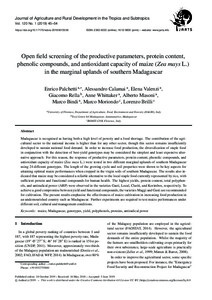| dc.date.accessioned | 2019-10-15T11:05:44Z | |
| dc.date.available | 2019-10-15T11:05:44Z | |
| dc.date.issued | 2019-10-14 | |
| dc.identifier | doi:10.17170/kobra-20190613556 | |
| dc.identifier.uri | http://hdl.handle.net/123456789/11323 | |
| dc.description | Gedruckte Ausg. im Verlag Kassel Univ. Press (www.upress.uni-kassel.de) erschienen. | |
| dc.language.iso | eng | |
| dc.rights | Urheberrechtlich geschützt | |
| dc.rights.uri | https://rightsstatements.org/page/InC/1.0/ | |
| dc.subject | maize | eng |
| dc.subject | Madagascar | eng |
| dc.subject | genotypes | eng |
| dc.subject | yield | eng |
| dc.subject | polyphenols | eng |
| dc.subject | proteins | eng |
| dc.subject | antiradical power | eng |
| dc.subject.ddc | 630 | |
| dc.title | Open field screening of the productive parameters, protein content, phenolic compounds, and antioxidant capacity of maize (Zea mays L.) in the marginal uplands of southern Madagascar | eng |
| dc.type | Aufsatz | |
| dcterms.abstract | Madagascar is recognised as having both a high level of poverty and a food shortage. The contribution of the agricultural sector to the national income is higher than for any other sector, though this sector remains insufficiently developed to sustain national food demand. In order to increase food production, the diversification of staple food in conjunction with the detection of best-yield genotypes may be considered the simplest and least expensive alternative approach. For this reason, the response of productive parameters, protein content, phenolic compounds, and antioxidant capacity of maize (Zea mays L.) were tested in two different marginal uplands of southern Madagascar using 24 different genotypes. The length of the growing cycle and soil properties were shown to be key aspects for attaining optimal maize performances when cropped in the virgin soils of southern Madagascar. The results also indicated that maize may be considered a reliable alternative to the local staple food currently represented by rice, with sufficient protein and functional compounds for human health. The highest yields, protein content, total polyphenols, and antiradical power (ARP) were observed in the varieties Gasti, Local, Clariti, and Korimbos, respectively. To achieve a good compromise between yield and functional compounds, the varieties Maggi and Gasti are recommended for cultivation. The present results emphasise the effectiveness of maize cultivation in increasing food production in an undernourished country such as Madagascar. Further experiments are required to test maize performances under different soil, cultural and management conditions. | eng |
| dcterms.accessRights | open access | |
| dcterms.creator | Palchetti, Enrico | |
| dcterms.creator | Calamai, Alessandro | |
| dcterms.creator | Valenzi, Elena | |
| dcterms.creator | Rella, Giacomo | |
| dcterms.creator | Whittaker, Anne | |
| dcterms.creator | Masoni, Alberto | |
| dcterms.creator | Bindi, Marco | |
| dcterms.creator | Moriondo, Marco | |
| dcterms.creator | Brilli, Lorenzo | |
| dc.type.version | publishedVersion | |
| dcterms.source.identifier | ISSN 1612-9830 | |
| dcterms.source.identifier | ISSN 2363-6033 | |
| dcterms.source.issue | No. 1 | |
| dcterms.source.journal | Journal of Agriculture and Rural Development in the Tropics and Subtropics (JARTS) | |
| dcterms.source.pageinfo | 45-54 | |
| dcterms.source.volume | Vol. 120 | |

